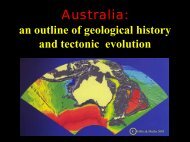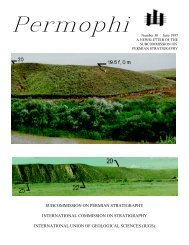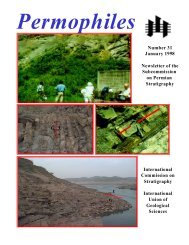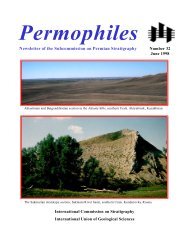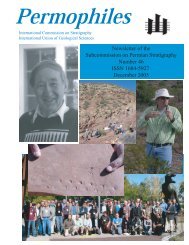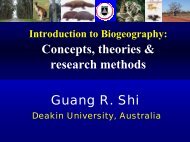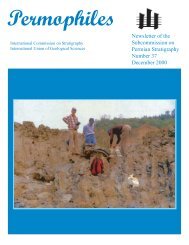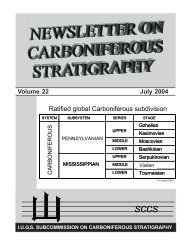Permophiles
Permophiles
Permophiles
You also want an ePaper? Increase the reach of your titles
YUMPU automatically turns print PDFs into web optimized ePapers that Google loves.
A Recommendation: A desirable area and sectionsfor the GSSP of the Changhsingian lower boundaryWang Cheng-yuanNanjing Institute of Geology and Palaeontology, Academia Sinica,Nanjing, 210008, China;Chen Li-deYichang Institute of Geology and Mineral Resources, CAGS,Yichang, 443003, ChinaTian Shu-ganInstitute of Geology , CAGS, Beijing, 100037, ChinaAbstractCurrent Changhsingian conodont taxonomy is very unstable.Mei et al.(1998) named three new species and two new subspeciesand recognized six conodont zones for the Changhsingian. Twoyears later, Wardlaw & Mei (in Jin, 2000a) abandoned these speciesconcepts, and put all Changhsingian gondolellid species intothree species based upon a new concept and proposed three conodontzones for the Changhsingian. Their new species conceptintroduced uncertainty to the conodont taxonomy. The origins ofClarkina subcarinata and C. wangi are still not clear and Clarkinachangxingensis cannot be used to define the base of theMeishanian Substage. The situation of the current work onChanghsingian conodonts is too premature. Much more extensivework on Changhsingian conodonts needs to be undertaken beforethese boundaries are defined.The Meishan sections are not suitable for establishment of abasal Changhsingian GSSP. The lower part of the Changhsing Limestonecontains neither ammonoids nor radiolarians because it is atypical shallow water facies and there is a gap between the LongtanFormation and the Changhsing Limestone. Conodont taxonomyrelated to the lineage from Clarkina orientalis to C. subcarinatacannot be solved in the Meishan sections. However, in W. Hubeiand W. Hunan, there are many Late Permian deep water faciesdeposits, yielding abundant conodonts, ammonoids and radiolarians.The boundary strata between the Wuchiaping Formation andDalung Formation are continuous deposits. The evolutionary lineagefrom Late Wuchiapingian Clarkina to Early ChanghsingianClarkina is well represented in this area. Huangyan section inHubei and Jiangya section in W. Hunan could be desirable sectionsfor selection of the base of the Changhsingian Stage GSSP.Current situation and problemsJin (2000c) reported in <strong>Permophiles</strong> 37 that “The Lopingianand its stages Wuchiapingian and Changhsingian have been acceptedas semi-formal units in the new international stratigraphicchart (Remane, 2000). It is important to keep this progress stableand therefore GSSPs for these two stages should be establishedas soon as possible”. However, the current situation of conodontstudy is too premature to define the base of the Changhsingian<strong>Permophiles</strong> Issue #39 20019Mei et al. (1998) proposed a refined succession ofChanghsingian and Griesbachian neogondolellid conodontsfrom the Meishan section; they named three new species andtwo new subspecies and recognized six conodont zones forthe Changhsingian. More importantly, they reported that thefour conodont species, Clarkina subcarinata, C. wangi, C.prechangxingensis and C. predeflecta, appeared simultaneouslyat the base of the Changhsingian (see Text-fig. 1 ofMei et al., 1998). After two years, they abandoned all newspecies and new subspecies named by Mei et al. (1998), aswell as the six conodont zones they had proposed. They havenow proposed three conodont zones for the Changhsingianand provided new diagnoses for three conodont species. “Wepick the point at the first appearance of adult forms with aclearly separate cusp, and partially discrete posterior carinaldenticles as the first occurrence of Clarkina subcarinata(sensu strictu) which is at 13.71m above the base of theChangxing Limestone at Meishan (D)” (Wardlaw and Mei, inYin et al., 2000a).In 2001, Mei et al. (2001a,b) changed the definition and thepoint for the base of the Changhsingian Stage. In the Augustpaper (Mei et al., 2001a) which appeared at the Changxingmeeting they concluded that “The first occurrences of Clarkinawangi should be somewhere within Bed 3, probably at thebase of Bed 3. We suggest that the base of the Changhsingianbe defined by the FAD of Clarkina wangi in section D atMeishan, Changxing County, China”. After a few months, theyfurther concluded that “the first occurrence of Clarkina wangishould be somewhere within Bed 3 or Bed 4. We suggest thatthe base of the Changhsingian be defined by FAD of Clarkinawangi in Section D at Meishan, Changxing County, China at apoint to be determined very soon.”Comparison of different definitions and points as proposedby Mei et al. (1998; 2000a in Yin) and Mei et al. (2001a.b) clearlydemonstrate that basal Changhsingian conodont taxonomy is farfrom mature. The definition and the point have changed too oftenand to quickly to trust them. Their species concept changed severaltimes and it has introduced a level of uncertainty to conodonttaxonomy, which demonstrates that it is too premature to definethe base of the Changhsingian.The origins of Clarkina subcarinata and wangi are still unclear.Nobody has clearly defined the morphocline from the uppermostWuchiapingian Clarkina to Changhsingian Clarkina. Themajor break in fauna parallels the big lithologic change betweenthe Wuchiapingian and Changhsingian. There is a gap betweenthe Wuchiapingian and Changhsingian at the Meishan section.We have to search a continuous Wuchiapingian- Changhsingiansection with continuous morphoclines between the uppermostWuchiapingian Clarkina to Changhsingian Clarkina and choosethe FAD of a well recognizable species as the marker for the base ofthe Changhsingian. This position should be close to the traditionalWuchiapingian-Changhsingian boundary. The GSSP shouldrest on a solid taxonomic base.Jin (2000b) states that the Lopingian Series “is subdividedinto the Wuchiapingian and Changhsingian Stage, each of whichcontains two substages”. The Wuchiapingian and Changhsingianbasal boundaries have not yet been defined. Two members of theChanghsingian Stage of Chao (1965) were named respectively bySheng and Jin in 1994 as two substages: the Baoqingian and the



